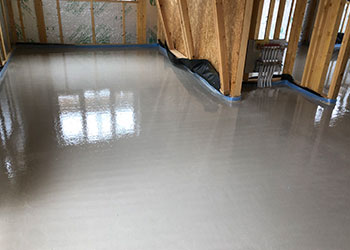When engaged on any construction project, one of the most import things that you need to consider is the flooring. It obviously needs to be as flat and level as humanly possible, and in order to achieve that, you need to lay a screed on top of the concrete substrate.
For many years, a screed was made up of simple sand and cement mixed on site and barrowed on to the concrete. It was then laid by hand by a worker on hands and knees using a trowel, which of itself is a lengthy and tiring process.
However, today, we are in the 21st century, and for the last 20 years or so there has been growing demand for liquid screeds which use calcium sulphate / gypsum instead of cement. These screeds have many advantages over and above sand and cement, not the least of which is the speed of laying. Instead of a worker on hands and knees, the liquid screeds that we provide at UK Screeds are delivered to site ready mixed.
We then very simply connect a pump and a long hose to the delivery truck and pump the screed into position. Working this way, we can cover an area of up to 2,000 square metres in a single day, which is as much as 20 times as fast as laying a sand and cement screed by hand!
When carrying out floor preparation in Bicester (pop. 33,154) or anywhere else, our floor screed is also self-levelling. As it is in liquid form, it is much the same as pouring water (or your beer, or whatever!) into a glass. Leave it for a couple of minutes and the surface is flat. The only thing that we then need to do is to run over it with a dappling bar just to get rid of any air bubbles. After that, it can just be left to dry.
Our liquid screed is also very fast drying. You can walk on it in 24 – 48 hours, so any other contractors that need to work on site are not delayed.
The Benefits Don’t Stop There
But the benefits don’t stop there. Many new build projects today incorporate underfloor heating, which itself has many advantages over and above a radiator system. Obviously, it is necessary to cover the heating pipes with the screed. Using a liquid screed, you only need to cover the pipes to a depth of about 30mm, making an overall depth of 45mm. This compares very favourable with sand and cement which must be at least 70mm overall, and often considerably more.
The result is that the liquid screed will heat up far faster than sand and cement because there is less of it to heat. It also has a thermal conductivity which is nearly twice that of sand and cement.
In addition, if you lay a sand and cement screed by hand, there are bound to be gaps and voids in some places around the pipes, so the heat transfer will not be completely even across the floor. With a liquid screed, the heat transfer into the room will be perfectly even because it will fully envelop the heating pipes.








